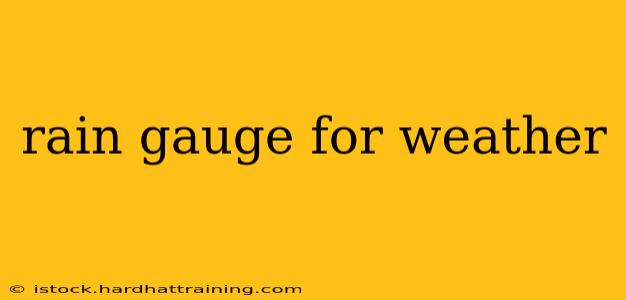Accurate weather forecasting and hydrological monitoring rely heavily on precise rainfall data. This is where the humble rain gauge plays a crucial role. Understanding the different types of rain gauges, their applications, and how to choose the right one for your needs is critical for anyone involved in meteorology, agriculture, or simply keen on tracking local weather patterns.
Understanding the Importance of Rain Gauges in Weather Monitoring
Rain gauges are essential instruments used to measure the amount of liquid precipitation (rain) that falls over a specific period. This seemingly simple measurement is fundamental to a wide range of applications:
- Meteorology: Accurate rainfall data is a cornerstone of weather forecasting models. Knowing the amount and intensity of rainfall helps meteorologists predict floods, droughts, and other weather-related events.
- Agriculture: Farmers rely on rainfall data to make informed decisions about irrigation, planting schedules, and crop management. Consistent rainfall monitoring helps optimize water usage and improve crop yields.
- Hydrology: Hydrologists use rain gauge data to understand water cycles, manage water resources, and predict potential flooding in rivers and watersheds.
- Environmental Studies: Rainfall data contributes to broader environmental monitoring and research, helping scientists study the impacts of climate change and understand ecosystem dynamics.
- Construction and Engineering: Accurate rainfall information is essential for designing and constructing drainage systems, dams, and other infrastructure projects.
Types of Rain Gauges: A Detailed Overview
Several types of rain gauges exist, each with its own advantages and disadvantages:
1. Non-Recording Rain Gauges
These gauges provide a single measurement of accumulated rainfall over a specific period (e.g., daily, weekly). They're relatively simple and inexpensive:
- Standard Rain Gauge: This is the most common type, featuring a funnel that collects rainwater into a graduated cylinder. The height of the water in the cylinder directly indicates the rainfall amount.
- Weighing Rain Gauge: This type measures rainfall by weighing the collected water. It offers higher accuracy, especially for small amounts of rain.
2. Recording Rain Gauges
These gauges automatically record rainfall data over time, providing a continuous record of precipitation events:
- Tipping Bucket Rain Gauge: This gauge uses a series of small buckets that tip over when filled with a predetermined amount of rain, generating an electrical signal that records the event.
- Weighing Bucket Rain Gauge: Similar to the weighing rain gauge mentioned above, this version automatically records weight changes over time, providing a continuous rainfall record.
- Optical Rain Gauge: This gauge uses a laser or infrared sensor to measure the amount of rainfall, offering high accuracy and minimal maintenance.
Selecting the Right Rain Gauge for Your Needs
Choosing the appropriate rain gauge depends on several factors:
- Accuracy Requirements: If high precision is needed (e.g., for scientific research), a weighing or optical rain gauge is recommended. For less demanding applications, a standard rain gauge may suffice.
- Budget: Non-recording rain gauges are generally less expensive than recording rain gauges.
- Data Needs: If you need continuous rainfall data, a recording rain gauge is essential. Non-recording gauges only provide a single measurement per observation period.
- Maintenance: Some gauges require more frequent maintenance than others. Consider the time and resources you can dedicate to gauge upkeep.
- Installation Location: The location of the rain gauge is critical for accurate readings. Ensure it's placed in an open area, away from obstructions that could affect rainfall collection.
Installation and Maintenance Best Practices
Proper installation and regular maintenance are crucial for obtaining reliable data from your rain gauge. This includes:
- Level Ground: Ensure the gauge is placed on level ground to prevent inaccurate measurements.
- Obstruction-Free Area: Avoid placing the gauge near trees, buildings, or other structures that could interfere with rainfall collection.
- Regular Cleaning: Clean the gauge regularly to remove debris and ensure accurate readings.
- Calibration: Periodic calibration is essential to maintain the accuracy of the gauge.
By understanding the different types of rain gauges and following best practices for installation and maintenance, you can ensure accurate and reliable rainfall data for various applications, contributing to better weather forecasting, resource management, and environmental monitoring.
